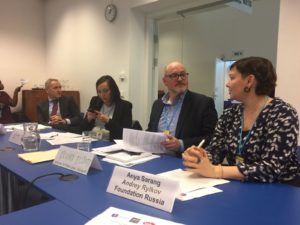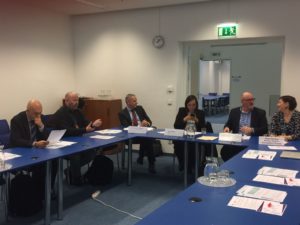Side Event ‘Addressing and Reversing the Harms of Drug Control in Eastern Europe and Central Asia’ was organised by AFEW International, the Canadian HIV/AIDS Legal Network, the Andrey Rylkov Foundation for Health and Social Justice, and the International Drug Policy Consortium during the 60th Commission on Narcotic Drugs in Vienna in March 2017.
Richard Elliot (Canadian HIV/AIDS Legal Network): To provide a public health overview. Punitive approaches to drug control in the region are rife. But also resources and energy are devoted to law enforcement, rather than public health. Unbalanced situation. In many countries, criminal provisions impose liability for possession for personal use. Even if there’s no criminal sanction, the administrative penalty is used as a platform for rights abuses. Illegal searches, arbitrary detention. In terms of procedural rights, repeated instances of improper procedures in terms of handling of evidence, inaccurate investigation, inflation of quantities of possession, coercion through violence, fostering/inducing withdrawal to extract confessions. There is a general failure to consider someone’s drug dependence when deciding how to apply the law. The right to health is widely affected. There’s a cruel irony in the fact that the criminalisation of people who use drugs is coupled with lack of access to treatment for dependence. Criminalisation pushes people away from services, which are scarce themselves (OST, ART, NSP) or completely absent. There is a case on Russia’s denial to provide OST before CEDH. This denial violates the provisions on torture, privacy and discrimination of the European Convention on Human Rights. Both the ECOSOC and HRC have expressed concern about Russia’s refusal to offer OST. In prison settings, the situation is even more acute. In some countries, bureaucracies also create barriers to access. Ex.the confluence of multiple health conditions is something that sometimes public health systems in the region are incapable of handling. Beyond this, there’s an issue of access to opiate pain medication. Also, women are disproportionately affected by these policies. For instance, even if WHO guidelines have established OST during pregnancy is viable and advisable, many countries prohibit it; adding gender discrimination to the list of abuses in the name of punitive drug control. The right to privacy of people who use drugs is also consistently violated, including the release of medical records to the public. What to do? Abolish all criminal and administrative liabilities for possession for personal use of illicit substances. Improve access to legal aid services. Work with law enforcement to reduce punitive and torturous practices. Stronger legal foundation that facilitates access to harm reduction and treatment service. Increase funding. In many domestic legal orders, the constitution stipulates human rights protection; they should be expanded to people who use drugs.
 Anya Sarang (Andrey Rylkov Foundation): Russia is probably the epicentre of abysmal drug policy that fuels AIDS epidemic in our region. The HIV epidemic is progressively under control according to WHO. Relatively static numbers for new infections in most regions of the world. But new HIV infections are sharply increasing in our region. Russia has the fastest growing HIV epidemic in the world. The Federal AIDS Centre in Russia reports every day 300 people get infected with HIV. Everyday 60 people die of AIDS in Russia. Estimates 3m infected. Official numbers suggest less than 1/3 have access to ART. 10 years ago, 80% of cases were related to injecting drug users. It’s still 55%. The primary cause of death related to AIDS is tuberculosis. One of the few countries where tuberculosis is still a major killer for people with HIV. Hepatitis also a significant co-morbitidy that adds to the burden of disease. Russia is openly resistant to evidence-based internationally-recommended practices, programmes and treatment. Not only does the government refuses to finance these, it opposes them. The national strategy describes NSP as a threat to the counter-drug strategy. Most international donors left the country. 90% decrease of harm reduction programmes in Russia as a result. From 104 programmes to 16. There is no new sources of support on the horizon. During the 2016, 8 organisations have been included in the list of “foreign agents”, including ours, because we receive foreign funding. It means the organisations cannot receive any money from governmental sources. It is necessary to provide more truthful information to the international community and donors. We provide support for drug users through outreach services, provide sterile needles and syringes, peer counselling and support, referral to health services. Almost 3000 benefited from our services. 736 lives saved as a result of naloxone distribution. The Street Lawyers programme documents human rights abuses and provides support to access legal services. Strategic litigation cases. The experience of the Foundation and like-minded organisations demonstrate it is still possible to provide services. We are committed to the protection of the rights of our community.
Anya Sarang (Andrey Rylkov Foundation): Russia is probably the epicentre of abysmal drug policy that fuels AIDS epidemic in our region. The HIV epidemic is progressively under control according to WHO. Relatively static numbers for new infections in most regions of the world. But new HIV infections are sharply increasing in our region. Russia has the fastest growing HIV epidemic in the world. The Federal AIDS Centre in Russia reports every day 300 people get infected with HIV. Everyday 60 people die of AIDS in Russia. Estimates 3m infected. Official numbers suggest less than 1/3 have access to ART. 10 years ago, 80% of cases were related to injecting drug users. It’s still 55%. The primary cause of death related to AIDS is tuberculosis. One of the few countries where tuberculosis is still a major killer for people with HIV. Hepatitis also a significant co-morbitidy that adds to the burden of disease. Russia is openly resistant to evidence-based internationally-recommended practices, programmes and treatment. Not only does the government refuses to finance these, it opposes them. The national strategy describes NSP as a threat to the counter-drug strategy. Most international donors left the country. 90% decrease of harm reduction programmes in Russia as a result. From 104 programmes to 16. There is no new sources of support on the horizon. During the 2016, 8 organisations have been included in the list of “foreign agents”, including ours, because we receive foreign funding. It means the organisations cannot receive any money from governmental sources. It is necessary to provide more truthful information to the international community and donors. We provide support for drug users through outreach services, provide sterile needles and syringes, peer counselling and support, referral to health services. Almost 3000 benefited from our services. 736 lives saved as a result of naloxone distribution. The Street Lawyers programme documents human rights abuses and provides support to access legal services. Strategic litigation cases. The experience of the Foundation and like-minded organisations demonstrate it is still possible to provide services. We are committed to the protection of the rights of our community.
Victor Sannes (Ministry of Health and Social Welfare of the Netherlands): We value a balanced approach between public health and law enforcement efforts. We’ve come to realise there has been a disproportionate accent on the law enforcement aspect. It’s not about choosing between approaches, but combining them. There’s no “one size fits all solution”. A public health approach requires the deployment of a wide range of initiatives: prevention efforts to avoid or delay uptake as much as possible, risk and harm reduction interventions, etc. The basis of this policy lies in the law enforcement policy. The police were fed up in the 1970s, as the country dealt with street heroin use and related challenges. The Dutch government implemented comprehensive harm reduction interventions. And these policies are implemented with the collaboration between institutions and agencies, as well as people who use drugs, is fluid.
 Question 1: What can the international community do to improve the quality of life of people who use drugs in Russia?
Question 1: What can the international community do to improve the quality of life of people who use drugs in Russia?
Anya Sarang: We sometimes have a feeling of isolation. Donors say we cannot do anything. It is important to remind GF donors and board, as well as other donors, that there’s still a need and good work being done on the ground. WE have evidence about our direct impact on people’s lives through our distribution of condoms and naloxone.
Richard Elliot: Important to use international mechanisms to keep attention on this situation. Monitoring state compliance with human rights, etc. At CND, underscore slow-motion genocide of people who inject and use drugs. Denying OST despite the evidence of the death that this produces is on a par with extrajudicial executions and the death penalty.
Comment by the Russian representative:
1) The first question should be “what is prohibited and allowed in Russia”? We cannot allow for activities that are not legal in our country. Last year Russia adopted a new national strategy on combating HIV/AIDS epidemic. We hosted Michel Kazatchkine, to visit some cities in Russia. He decided which cities to visit. He examined the new strategy. His opinion is that the situation improved. He will visit Russia again in a couple of years and compare. We are open for discussion on this particular issue.
2) If some activities are prohibited, we do not allow civil society representatives to continue these activities. Each and every country does the same. There is a huge scope of activities with regards to UNODC/WHO HIV Unit Technical Guide that Russia implements. OST is prohibited. We don’t treat drug users with another substance containing drugs. But we use naltrexone, an opioid antagonist, which blocks receptors. It’s a medication, not a drug.
3) We provide people with a whole range of measures on demand reduction and they work.
Richard Elliot – If you withhold treatment that is evidence-based, and this leads to the death of hundreds of thousands…I think it’s not a mischaracterisation, to say it’s akin to genocide.
Source: CND Blog



